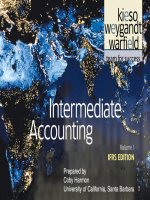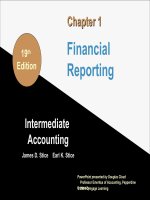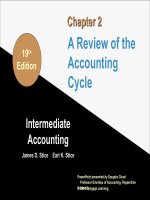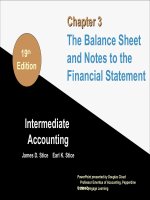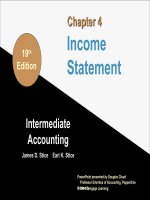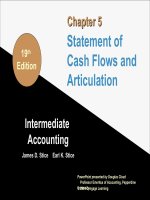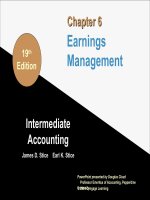Intermediate accounting 19th by stice stice chapter 03
Bạn đang xem bản rút gọn của tài liệu. Xem và tải ngay bản đầy đủ của tài liệu tại đây (161.53 KB, 58 trang )
Chapter 3
19th
Edition
The Balance Sheet
and Notes to the
Financial Statement
Intermediate
Accounting
James D. Stice
Earl K. Stice
PowerPoint presented by Douglas Cloud
Professor Emeritus of Accounting, Pepperdine
University
© 2014 Cengage Learning
3-1
Elements of the Balance Sheet
Identification and measurement of assets
and liabilities is fundamental to the
practice of accounting.
Assets and liabilities are usually
separated into current and noncurrent
categories.
Current items are those expected to be
used or paid within one year.
(continued)
3-2
Elements of the Balance Sheet
•
•
•
A balance sheet presents a listing of an
organization’s assets and liabilities at a
certain point in time.
The difference between assets and liabilities
is called equity.
The balance sheet is designed using the
basic accounting equation:
Assets = Liabilities + Owners’ Equity
3-3
Working Capital
•
•
•
The difference between current assets
and current liabilities is referred to as
the company’s working capital.
Working capital is the liquid buffer
available in meeting financial demands
and contingencies of the near future.
The division of assets and liabilities into
current and noncurrent is in some
sense an arbitrary partition.
3-4
Current Assets
Cash and resources expected to be
converted to cash during the entity’s
normal operating cycle or one year,
whichever is longer, are current
assets:
• Cash
• Receivables
• Inventories
3-5
Current Assets
The normal operating cycle involves
the use of cash to purchase
inventories, the sale of inventories
resulting in receivables, and ultimately
the cash collection of those
receivables.
3-6
Current Assets
•
In addition to cash, receivables, and
inventories, current assets typically
include prepaid expenses and
investments in certain securities.
•
Debt and equity securities (often called
bonds and stocks) that are purchased
mainly with the intent of reselling these
securities in the short term are called
trading securities.
3-7
Current Assets
•
Current assets are normally listed on the
balance sheet before the noncurrent
assets and in the order of their liquidity,
with the most liquid items first.
•
•
Liquid refers to those closest to cash.
This order is a tradition, not a requirement.
3-8
Noncurrent Assets
Assets not qualifying for presentation
under the current heading are classified
under a number of noncurrent headings.
Noncurrent assets may be listed under
separate headings, such as:
• Investments
• Property, Plant, and Equipment
• Intangible Assets
• Other Noncurrent Assets
3-9
Investments
•
Investments held for such long-term
purposes as regular income,
appreciation, or ownership control are
reported under the heading
Investments.
•
The Investment heading also includes
other miscellaneous investments not
used directly in the operations of the
business.
3-10
Property, Plant, and Equipment
Property, Plant, and Equipment
includes properties of a tangible and
relatively permanent nature that are
used in the normal business operations,
such as:
• Land
• Buildings
• Machinery
• Tools
3-11
Intangible Assets
Intangible assets are long-term rights
and privileges of a nonphysical nature
acquired for use in business
operations, such as:
• Goodwill
• Patents
• Trademarks
• Franchises
3-12
Other Noncurrent Assets
Those noncurrent assets not suitably
reported under any of the previous
classifications may be listed under the
general heading “Other Noncurrent
Assets”:
• Long-term advances to officers
• Long-term receivables
• Deposits made with taxing authorities
and utility companies
• Deferred income tax assets
3-13
Deferred Income Tax Assets
Deferred income tax assets arise
when taxable income exceeds
reported income for the period and the
difference is expected to “reverse” in
future periods.
3-14
Current Liabilities
Current liabilities are those obligations that
are reasonably expected to be paid using
current assets or by creating other current
liabilities, such as:
• Accounts and notes payable
• Salaries payable
• Wages, interest, and taxes payable
• Current portion of long-term
obligations
3-15
Callable Obligations
•
A callable obligation is one that is
payable on demand and thus has
no specified due date.
•
If the terms of an agreement
specify that an obligation is due on
demand or will become due on
demand within one year from the
balance sheet date, the obligation
should be classified as current.
3-16
Objective Acceleration Clauses
•
Loan agreement clauses that identify
specific deficiencies that can cause a loan
to be immediately callable are referred to
as objective acceleration clauses.
•
If these deficiencies exist as of the balance
sheet date, the associated liability should
be classified as current unless the lender
has agreed to waive the right by the time
the financial statements are issued.
3-17
Subjective Acceleration Clauses
• In some cases, the debt agreement does not
specifically identify the circumstances under
which a loan will become callable, but it does
indicate some general conditions that permit
the lender to accelerate the due date. This
type of provision is known as subjective
acceleration clauses.
• If invoking the clause is considered to be
reasonably possible but not probable, only a
note disclosure is necessary.
3-18
Noncurrent Liabilities
Obligations not reasonably expected to be
paid or otherwise satisfied within 12
months are classified as noncurrent
liabilities. They are usually listed under
separate headings, such as:
• Long-Term Debt
• Long-Term Lease Obligations
• Deferred Income Tax Liability
• Other Noncurrent Liabilities
3-19
Long-Term Debt
•
•
Long-term notes, bonds, mortgages, and
similar obligations not requiring the use of
current funds for their retirement are
generally reported on the balance sheet
under the heading Long-Term Debt.
When the amount borrowed is not the same
as the amount ultimately required to be
repaid, called the maturity value, a
discount or premium is included as an
adjustment to the maturity value.
3-20
Long-Term Debt
•
•
•
A discount should be subtracted from the
amount reported for the debt.
A premium should be added to the amount
reported for the debt.
When a note, a bond issue, or a mortgage
formerly classified as a long-term obligation
becomes payable within a year, it should be
reclassified as a current liability except when
the obligation is to be refinanced.
3-21
Long-Term Lease Obligations
•
•
Some leases of property, plant, and
equipment are financially structured so that
they are essentially debt-financed
purchases.
The FASB has established criteria to
determine which leases are to be accounted
for as purchases, or capital leases, rather
than as ordinary leases.
3-22
Deferred Income Tax Liability
•
•
A deferred income tax liability can be
thought of as the income tax expected to
be paid in future years on income that
has already been reported in the income
statement but which, because of the tax
law, has not been taxed.
The liability is valued using the enacted
income tax rates expected to prevail in
the future when the income is taxed.
3-23
Other Noncurrent Liabilities
Those noncurrent liabilities not suitably
reported under the separate headings
outlined earlier may be listed under this
general heading or may be listed separately
under special descriptive headings.
Examples are:
• Pension plans
• Obligations resulting from advance
collections on long-term contracts
3-24
Contingent Liability
•
•
•
Past activities or circumstances may give rise to
possible future liabilities although obligations do
not exist on the balance sheet date. These
possible claims are known as contingent
liabilities.
If the future payment is considered probable, the
liability should be recorded by a debit to a loss
account and a credit to a liability account.
If future payment is possible, the contingent
nature of the loss is disclosed in a note to the
financial statements.
(continued)
3-25

